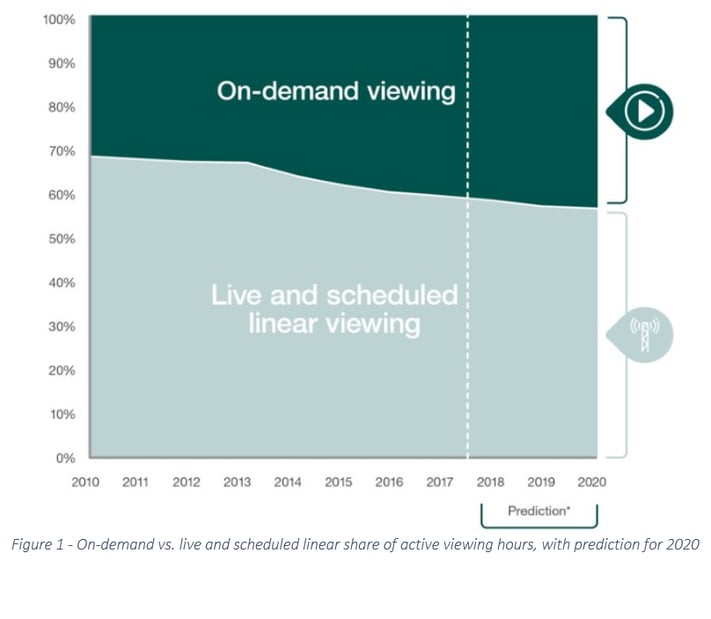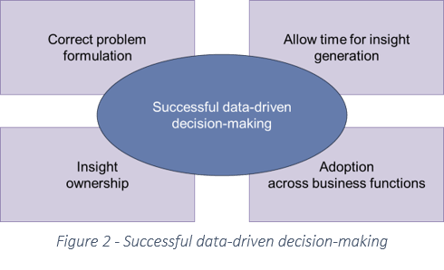Unlocking the value of Data-driven Insights in the Media Industry
Creating and deploying entertainment content are – among many media industry practices – experiencing rapid changes due to technical advancements within data analytics. The trend challenge conventional business and operating models since such analytics can translate into value through great customer insights[1]. Traditional content creation and distribution are therefore experiencing a surge in competition for customers’ attention and entertainment content consumption. Thus, maintaining high levels of reward and low levels of risks when creating content directly correlate with how media companies can attract customers and accurately predict the type of content they desire[2]. Our experience indicate that technical platforms are increasingly acknowledged and used, but the lack of full adoption by the organization impedes its full potential.
What triggered todays challenges in the media industry and how can they be overcome?
Media companies are adapting to consumers behavioral changes by transforming traditional content distribution towards on-demand alternatives such as online streaming and/or publication. This expands the variety of services from where customers can consume its desired content, resulting in lower levels of customer loyalty.
Technology enables fast changes to the industry and the maturity level has reached a point where customers not only demand easily accessed content on-demand, but also personalized content. An example is video content – and if such demands are not met – a company quickly becomes disregarded in favor of industry leaders such as Amazon, Netflix, etc. These industry leaders have even managed to remove advertising as a result of being able to maximize the returns and minimize risks of developed content.
 Today, most media companies use digital channels to distribute their content, thus enabling great amounts of customer data to be collected. That data can, thanks to technological improvements within data analytics, generate insights to improve customer retention and loyalty. Decision-making based on data-driven insights has proven to interpret and predict what customers seek, guiding content creators towards increased success rates.
Today, most media companies use digital channels to distribute their content, thus enabling great amounts of customer data to be collected. That data can, thanks to technological improvements within data analytics, generate insights to improve customer retention and loyalty. Decision-making based on data-driven insights has proven to interpret and predict what customers seek, guiding content creators towards increased success rates.
However, moving from data collection to generating insights and acting accordingly seems to encounter difficulties within many media companies[3]. The reasons behind this can be many. Some common ones include decision-making still being based on gut-feeling and lack of time for insights generation. Let’s visit a previous case from the media industry to investigate how such challenges were tackled.
Case: Adapting to consumers behavioral changes
Facilitating the transition towards being a data-driven organization should be a top priority for the media industry. Such was the case for one of the first commercially financed TV channels in the Nordics that Knowit helped transition into data-driven decision-making. The media company recorded changes in user habits, from watching TV traditionally towards streaming on-demand. Returns were decreasing, and the level of risk increasing due to poorer success rates when trying to match developed content with customers’ desires. Most of the content was developed from experience and gut-feel, and decision-making based on facts and customer insight was deemed necessary.
People with industry expertise, data scientists and engineers were combined to generate a correct problem formulation, and from there, design appropriate algorithms. At the beginning was the technical platform regarded as a full covering solution, but further challenges had to be overcome to achieve it. Dedication and time were needed to crunch the data and generate insights, as well as establishing ownership of insights to ensure full adoption throughout the decision process. Furthermore, generating great returns from such algorithm (i.e. accurate insights) also required training language models, ensuring quality and access to reliable data.
Dash-boards were used to present what the viewers were watching and through what distribution channel, together with the parameters that comprised the decision to consume certain content. Analysed parameters were – among other sources – derived from real time streams, digital and social media.
At the end, the Nordic TV company gained an overview and understanding of how the relation between different choices in production, impacted customer loyalty and choice of platform. Predictions also demonstrated how many viewers they would acquire on different concepts and which content they should develop and launch to maintain high levels of success rate. Estimations indicated savings of 50-100 MNOK, and increased revenues by optimizing advertising positioning.
To summarize, what is required to succeed with a transition into data-driven growth?
While the media industry experience challenges with great impact to their business, studies and previous cases do demonstrate that data-driven decision-making is one way to address the matter. In short, maintaining high levels of reward and low levels of risks when developing content, directly correlate with how media companies can attract customers and accurately predict what content is desired. Besides acquiring the necessary technology and enabling data transparency within the organization, one provenly must ensure these four key aspects:
- Correct problem formulation by business people
- Allow time to be dedicated to insight generation by both business people and data analysts
- Insight ownership throughout the entire organizational structure, since data does not follow a business function but rather a process
- Adoption of decision-making based on insights across business functions

These are learnings based on the case, but the key aspects have been found to always be necessary, regardless of industry.
If you’re considering implementing a data-driven decision-making outside the media industry, as exemplified here, you should regard the business case. There are several examples of published studies, where the highest value that can be expected from advanced analytics and data-driven decision-making is mapped[4,5]. Leveraging knowledge about where your organization could benefit from becoming data-driven, common challenges and an understanding of the current state, can together give insight into what your next data analytics initiative is.
This white paper covers some challenges within the area of Data-Driven Growth, stay tuned for more insights to be uncovered.
References
- Duncan, A., Buytendijk, F. and Logan, V. (2018). How Chief Data Officers Show Leadership in Improving Data Literacy and Fostering a Data- Driven Culture. Gartner.
- Elizalde, F., Sabia, A. and Zlotogorski, M. (2018). Cool Vendors in AI for Media and Entertainment. Gartner.
- Shen, N., Linden, A., Idoine, C. and Hare, J. (2018). Six Pitfalls to Avoid When Planning Data Science and Machine Learning Projects. Gartner.
- Lo, T. (2018). Competitive Landscape: Data and Analytics Service Providers. Gartner.
- McKinsey & Company. (2018). The age of analytics: Competing in a data-driven world. [online] Available at: https://www.mckinsey.com/business-functions/mckinsey-analytics/our-insights/the-age-of-analytics-competing-in-a-data-driven-world [Accessed 19 Dec. 2018].



